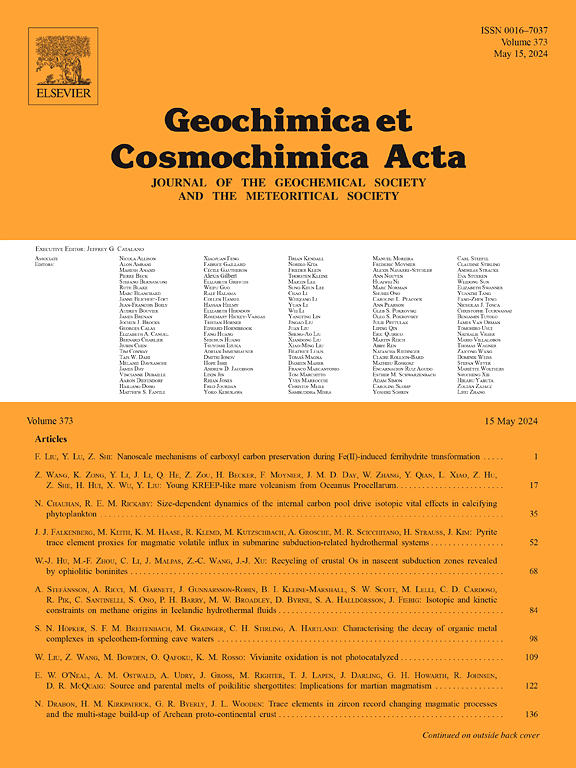Antimony stable isotope fractionation during adsorption onto birnessite: A molecular perspective from X-ray absorption spectroscopy and density functional theory
IF 4.5
1区 地球科学
Q1 GEOCHEMISTRY & GEOPHYSICS
引用次数: 0
Abstract
Sorption of antimony (Sb) onto birnessite significantly influences the fate of Sb in oceanic and terrestrial environments and fractionates Sb isotopes. Nevertheless, little is known about Sb isotopic fractionation during its adsorption on birnessite. Here, we show the value of Δ123Sbadsorbed-aqueous increases from −0.398 to −0.332 ‰ in 1 h and then decreases and stabilizes at −0.384 ‰ in 72 h. The enrichment of the light Sb isotope is predominantly due to the distortion of the octahedral symmetry. X-ray absorption spectroscopy results indicate Sb first forms a double-corner-sharing complex on birnessite and then transforms to a double-edge-sharing complex during adsorption. The optimized bond distances for double-corner-sharing (3.37 Å) and double-edge-sharing (2.90 Å) complexes calculated using density functional theory (DFT) fits well with the structure (3.41 and 3.00 Å) revealed by X-ray absorption spectroscopy, respectively. The fractionation derived from reduced partition function ratios calculated using DFT aligns well with the experimental results. Therefore, the variation in Sb isotopic fractionation during adsorption is attributed to the evolving structure of Sb complexes on birnessite. Our results demonstrate the isotopic fractionation of Sb during adsorption on birnessite and provide a molecular-scale understanding of Sb behavior, contributing to the correct reconstruction of the Sb isotope composition of ancient seawater using ferromanganese crusts and nodules, and efforts to trace Sb migration in epigenetic mining environments.
锑在吸附到桦皮岩过程中的稳定同位素分馏:从分子角度看 X 射线吸收光谱和密度泛函理论
锑(Sb)在白腊石上的吸附作用极大地影响了锑在海洋和陆地环境中的归宿,并使锑的同位素发生分馏。然而,人们对锑在桦锑酸盐吸附过程中的同位素分馏知之甚少。在这里,我们展示了吸附在水体中的Δ123Sb的值在1小时内从-0.398 ‰增加到-0.332 ‰,然后在72小时内降低并稳定在-0.384 ‰。X 射线吸收光谱结果表明,锑首先在比尔奈斯特上形成双角共享复合物,然后在吸附过程中转变为双边共享复合物。用密度泛函理论(DFT)计算出的双角共享复合物(3.37 Å)和双边共享复合物(2.90 Å)的优化键距分别与 X 射线吸收光谱显示的结构(3.41 Å 和 3.00 Å)非常吻合。使用 DFT 计算的还原分配函数比得出的分馏结果与实验结果非常吻合。因此,吸附过程中锑同位素分馏的变化归因于硼锰铁矿上锑络合物结构的演变。我们的研究结果证明了锑在桦锰矿上吸附过程中的同位素分馏,并提供了对锑行为的分子尺度理解,有助于利用铁锰结壳和结核正确重建古海水的锑同位素组成,并努力追踪锑在表生采矿环境中的迁移。
本文章由计算机程序翻译,如有差异,请以英文原文为准。
求助全文
约1分钟内获得全文
求助全文
来源期刊

Geochimica et Cosmochimica Acta
地学-地球化学与地球物理
CiteScore
9.60
自引率
14.00%
发文量
437
审稿时长
6 months
期刊介绍:
Geochimica et Cosmochimica Acta publishes research papers in a wide range of subjects in terrestrial geochemistry, meteoritics, and planetary geochemistry. The scope of the journal includes:
1). Physical chemistry of gases, aqueous solutions, glasses, and crystalline solids
2). Igneous and metamorphic petrology
3). Chemical processes in the atmosphere, hydrosphere, biosphere, and lithosphere of the Earth
4). Organic geochemistry
5). Isotope geochemistry
6). Meteoritics and meteorite impacts
7). Lunar science; and
8). Planetary geochemistry.
 求助内容:
求助内容: 应助结果提醒方式:
应助结果提醒方式:


